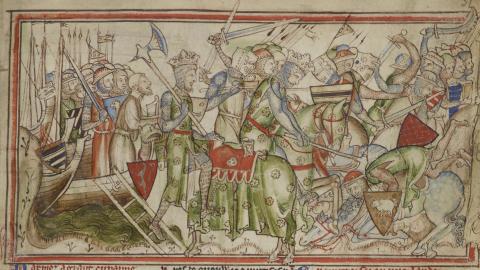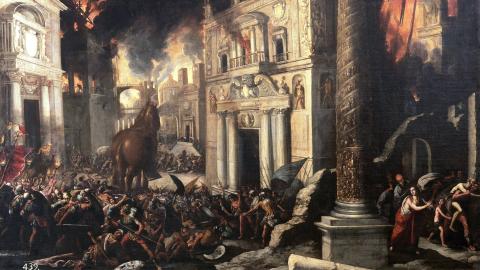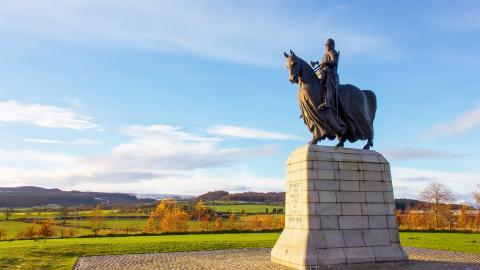The Battle of Hastings
It’s no understatement to say that the day-long battle changed the course of history
War: The Battle of Hastings
Dates: 14th October 1066
Place: Hastings, East Sussex, UK
Belligerents: Norman-French Army & Anglo-Saxon England
Although they’re probably busy trying to forge a lucrative YouTube career ask any British schoolchild when the Battle of Hastings was and they will – should – reply as one; 1066.
Perhaps the most famous date in British history, the battle pitched Anglo-Saxon king Harold Godwinson’s army against a Norman-French army led by William, Duke of Normandy, and it was a fight for the ultimate prize – the crown of England.
It’s no understatement to say that the day-long battle changed the course of history and brought about a cultural and political transformation that fundamentally altered how the country was governed, its language, laws, customs and, as we can still witness to this day, its architecture.
It all started with a row
Most wars start with two parties disagreeing with the standpoint of the other and this was no exception. When King Edward the Confessor, despite being married, died childless in January 1066, French duke William of Normandy (later, the Conqueror) claimed that his distant cousin Edward had promised him the throne as early as 1051. Edward had spent half his life in exile in France and apparently felt a debt of gratitude to his landlords.
However, Edward’s brother-in-law Harold (claiming the old man nominated him in the hours before he died) was crowned King soon after he checked out and William was understandably apoplectic with rage.
Naturally with any contentious decision, there were challenges. They came in the form of invasions, first from, bizarrely, Harold’s own brother Tostig (a flimsy claimant to the throne) and Norwegian king Harald Hadrada who overran a hastily formed rabble of Englishmen at the Battle of Fulford near York on 20th September 1066. Just five days later, Tostig and Hadrada were killed at the Battle of Stamford Bridge in the East Riding of Yorkshire.
That left William as King Harold’s only serious challenger, and he was serious. Very serious.
Pick a number…
Just three days after Stamford Bridge William landed a massive invasion force at Pevensey, close to the Sussex coast, having made their way across the English Channel from Normandy.
The size of William’s army has been lost to history. His chaplain William of Poitiers suggested there were 60,000 men and two other chroniclers of the time went as high as 150,000 but in reality, no armies in medieval times were ever that big. Contemporary reports put the Norman-French numbers at between 7,000 and 12,000 but this relies on little more than guesswork from Victorian-era historians and the numbers of Harold’s battle-weary troops are even less accurate with the number most likely somewhere between 5,000 and 13,000.
Hastings? Probably not…
The Battle of Hastings actually took place at a place called Battle, seven miles north of Hastings so it should be more accurately called the Battle of Battle, but that’s a row for another day. It was written in the Domesday Book as ‘bellum Hasetingas’ or Battle of Hastings, so that’s how it stays.
The actual battle
At dawn on October 14th 1066, Harold’s army occupied a ridge in the town and William was ready for a fight. The soon-to-be Conqueror arranged his archers and crossbowmen in the front line, heavy infantry just behind and knights to the rear – Normans in the centre, Bretons on the left and French on the right.
While Harold’s army had the upper ground, they lacked archers and cavalry and basically had to fight where they stood. Harold, his housecarls (the rather excellent word for members of the bodyguard of a Danish or English king) and his other trained troops – of which there weren’t that many after the skirmishes up north – were positioned at the summit and he placed his other fighting men along the crest of the ridge where he thought he could protect both flanks.
The trouble was that their position was too small and for some, there was literally no room to fight. Many withdrew and the ones that remained became sitting ducks for William’s archers.
The heavily-armoured charging knight on horseback with a heavy lance was still a century away, Norman military protection was flimsy for both man and animal and close-quarters fighting ensued with Harold relying on a strong shield wall, keeping the line solid and casualties to a minimum. The idea was that by doing this, the Normans would tire.
‘Far and wide, the earth was covered with the flower of the English nobility and youth, drenched in blood.’
It was a real ding-dong battle. End-to-end stuff. William’s archers opened at close quarters but took heavy casualties from the English slings and spear attacks. Williams threw his cavalry in who took a mauling, panicked and ran for it. Crucially, this retreat managed to draw the English from their positions and turned the battle. Towards mid-afternoon, the English defence was low on numbers and exhausted and Harold’s brothers, Gyrth and Leofwine were both killed on the battlefield. As dusk drew in, Harold, according to the Bayeux Tapestry, was killed by a Norman arrow through the eye although the debate about his final demise rages on and on...
By all accounts, it was a very bloody battle. Writing soon after, William of Poitiers said that ‘far and wide, the earth was covered with the flower of the English nobility and youth, drenched in blood.’
Save for a last, desperate rally, the English were defeated. William had indeed conquered. Very quickly he marched on London and was crowned King William I on Christmas Day 1066 at Westminster Abbey.
Four years later, Pope Alexander II ordered William to make penance for his invasion so he commissioned Battle Abbey, one of the most famous historical sites in England and one that stands proudly to this day.
The aftermath
The Anglo-Saxons had ruled England for over 600 years but there was a new sheriff in town.
The Normans imposed huge, all-encompassing changes to the country they had just conquered. French became the language spoken at court for centuries and mixed with Anglo-Saxon, developed into the modern form of English we speak today.
The new rulers imposed new laws, forged important links with France and the rest of Europe and to secure a hold on power, a remarkable wave of castle building began including Dover Castle, The Tower of London, Windsor Castle, Corfe Castle, Pevensey Castle, Colchester Castle – home to the largest surviving Norman keep in Europe and Leeds Castle, described on their own website as ‘the loveliest castle in the world.’
















